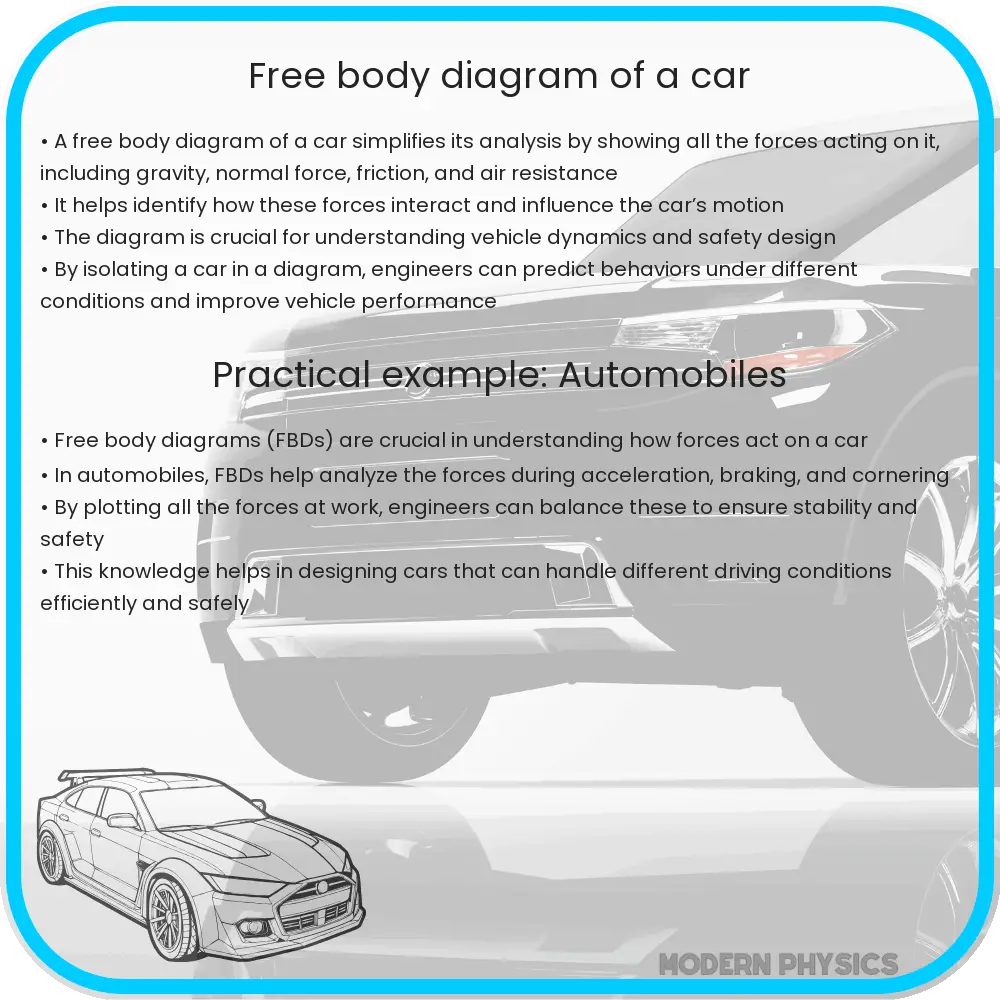Explore the mechanics of cars with Free Body Diagrams: Understand forces, equilibrium, and their impact on automotive design and safety.

Understanding the Free Body Diagram of a Car: Mechanics, Forces, and Equilibrium
In the study of mechanics, a Free Body Diagram (FBD) is an essential tool used to analyze the forces acting on an object. When it comes to understanding the dynamics of a car, the FBD plays a crucial role in visualizing the forces and moments that influence its motion and stability. This article delves into the key concepts of FBDs in the context of a car, exploring how these diagrams help in comprehending the mechanics of automotive motion and equilibrium.
Breaking Down the Forces on a Car
At its core, the FBD of a car involves breaking down and illustrating all the forces acting upon it. These forces typically include:
- Gravity: Acting downwards, it’s represented by the weight of the car, typically at its center of gravity.
- Normal Force: Perpendicular to the surface, this force counteracts gravity and varies depending on the car’s weight and the terrain.
- Frictional Force: This force, acting parallel to the road surface, is crucial in enabling the car to move forward or slow down.
- Air Resistance: Often illustrated as a backward force, it increases with the car’s speed.
Each force is represented by arrows, with their direction and magnitude corresponding to the force’s nature and impact on the car. Understanding these forces is pivotal in analyzing a car’s motion under various conditions.
Analyzing Equilibrium and Motion
In a state of equilibrium, the sum of all forces and moments acting on the car is zero. This balance is vital for a car’s steady motion or stationary state. The FBD helps in understanding scenarios like:
- Stationary Car: When a car is at rest, the downward gravitational force is balanced by the normal force from the ground, and there’s no net horizontal force.
- Moving Car: While in motion, additional forces like thrust (from the engine) and air resistance come into play. The FBD aids in understanding how these forces interact to maintain motion.
Through the application of Newton’s laws of motion, the FBD becomes a powerful tool for predicting and analyzing a car’s behavior under various conditions. For instance, the first law – an object in motion stays in motion unless acted upon by an external force – can be visually represented and understood through an FBD.
An FBD not only helps in comprehending the current state of a vehicle but also in designing safer and more efficient cars. By analyzing these diagrams, engineers can make informed decisions about weight distribution, engine placement, and overall design to enhance performance and safety.
In the next section, we will explore how the FBD is utilized in various automotive applications, including braking, acceleration, and turning, and the role it plays in vehicle design and safety considerations.
Application of Free Body Diagrams in Automotive Design and Safety
The use of Free Body Diagrams extends far beyond basic mechanics. In the automotive industry, they are instrumental in enhancing vehicle design, performance, and safety. By analyzing FBDs, engineers can optimize various aspects of a car, leading to innovations in efficiency and safety. Key applications include:
- Braking System Design: FBDs help in understanding the distribution of forces during braking, allowing for the development of systems that minimize stopping distance while preventing skidding.
- Enhancing Acceleration: By examining the forces involved in acceleration, engineers can tweak engine performance and weight distribution for optimal acceleration.
- Turning Dynamics: FBDs are crucial in analyzing forces during turns, influencing decisions on tire grip, suspension design, and stability control systems.
Role in Vehicle Safety
Vehicle safety is another area where FBDs play a critical role. By understanding how forces act in different scenarios, such as collisions or abrupt maneuvers, manufacturers can design safer vehicles. This includes the strategic placement of airbags, reinforcement of vehicle structure, and the development of advanced driver-assistance systems (ADAS).
Teaching and Learning Tool
Beyond the automotive industry, FBDs are valuable educational tools. They offer a visual and intuitive method for students to grasp complex concepts in physics and engineering. By simplifying real-world scenarios into manageable components, FBDs make learning more engaging and effective.
Conclusion
The Free Body Diagram is an indispensable tool in understanding and analyzing the forces acting on a car. From aiding in the design of high-performance vehicles to ensuring safety, FBDs provide a clear and concise way to visualize and solve complex problems in mechanics. Their application extends from the drawing boards of engineers to the classrooms of educators, making them a cornerstone in the field of automotive mechanics and physics education. In essence, the FBD is not just a diagram but a gateway to a deeper understanding of the physical world, especially in the dynamic and ever-evolving realm of automotive technology.
